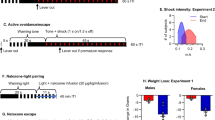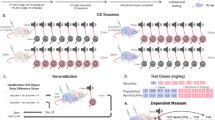Abstract
To date, only 1 study has evaluated the impact of a Pavlovian drug conditional stimulus (CS) on operant responding. A within-subject operant 1-lever go/no-go (across sessions) design was used to evaluate the impact of Pavlovian contingencies on the discriminative stimulus effects of nicotine (0.4 mg/kg) and ethanol (800 mg/kg) in male Sprague Dawley rats. Drugs were administered 10 min before each acquisition and test session. One drug predicted sessions of food reinforcement and the other drug predicted sessions of nonreinforcement; stimulus roles were counterbalanced. In Experiment 1 (n = 7), operant lever pressing was initially maintained on a VI-30 s schedule of food reinforcement. This phase was followed by 20 (CS+ vs. CS-) Pavlovian drug discrimination training sessions without the levers present. Two extinction tests revealed significantly more operant lever pressing under the CS+ drug conditions compared to the CS- drug conditions, suggesting evidence for Pavlovian-instrumental transfer. Operant training significantly strengthened stimulus control. In Experiment 2 (n = 7), the drugs functioned as operant drug discriminative stimuli first. Next, the predictive roles of the drug SDs and SΔs were reversed under Pavlovian CS- and CS+ contingencies, respectively. The original stimulus control was significantly undermined but was not reversed. These studies suggest that Pavlovian drug-reinforcer contingencies embedded within the operant 3-term contingency may play a partial role in mediating the discriminative stimulus effects of drugs.
Similar content being viewed by others
References
BEARDSLEY, P. M., ANTHONY, E. W., & LOPEZ, O. T. (1992). Phencyclidine established as a discriminative stimulus using ethanol as a reinforcer. Behavioural Pharmacology, 3, 497–505.
BESHEER, J., PALMATIER, M. I., METSCHKE, D. M., & BEVINS, R. A. (2004). Nicotine as a signal for the presence and absence of sucrose reward: a Pavlovian drug appetitive conditioning preparation in rats. Psychopharmacology, 172, 108–117.
BEVINS, R. A., WILKINSON, J. L., PALMATIER, M. I., SIEBERT, H. L., & WILTGEN, S. M. (2005). Characterization of nicotine’s ability to serve as a negative feature in a Pavlovian appetitive conditioning task in rats. Psychopharmacology, July 27 (ahead of print), 1–12.
BOUTON, M. E., & BROOKS, D. C. (1993). Time and context effects on performance in a Pavlovian discrimination reversal. Journal of Experimental Psychology: Animal Behavior Processes, 19, 165–179.
BORMANN, N. M., & OVERTON, D. A. (1993). Morphine as a conditioned stimulus in a conditioned emotional response paradigm. Psychopharmacology, 112, 277–284.
CAPALDI, E. J., & STEVENSON, H. W. (1957). Response reversal following different amounts of training. Journal of Comparative and Physiological Psychology, 50, 195–198.
CATANIA, A. C. (1971). Discriminative stimulus functions of drugs: Interpretations. In T. Thompson & R. Pickens (Eds.) Stimulus properties of drugs (pp. 149–155). New York: Appleton-Century-Crofts.
COLPAERT, F. C. (1977). Drug produced cues and states: Some theoretical and methodological inferences. In H. Lal (Ed.), Discriminative stimulus properties of drugs (pp. 5–21). New York: Plenum.
COLWILL, R. M., & RESCORLA, R. A. (1990). Evidence for the hierarchical structure of instrumental learning. Animal Learning & Behavior, 18, 71–82.
CONKLIN, C. A., & TIFFANY, S. (2002). Applying extinction research and theory to cue-exposure addiction treatments. Addiction, 97, 155–167.
ESTES, W. K., & SKINNER, B. F. (1941). Some quantitative properties of anxiety. Journal of Experimental Psychology, 29, 390–400.
GARNER, H. R., WESSINGER, W. D., & McMILLAN, D. E. (1996). Effect of multiple discrimination reversals on acquisition of a drug discrimination task in rats. Behavioural Pharmacology, 7, 200–204.
HARLOW, H. F. (1949). The formation of learning sets. Psychological Review, 56, 51–65.
HOLLAND, P. E. (2004). Relations between Pavlovian-instrumental transfer and reinforcer devaluation. Journal of Experimental Psychology: Animal Behavior Processes, 2, 107–114.
JARBE, T. U. C., HILTUNEN, A. J., & SWEDBERG, M. D. B. (1989). Compound drug discrimination learning. Drug Development Research, 16, 111–122.
MAES, J. H. R., & VOSSEN J. M. H. (1997). Conditional control by midazolam and amphetamine in a rapid appetitive discrimination procedure. European Journal of Pharmacology, 319, 5–11.
McMILLAN, D. E., WESSINGER, W. D., PAULE, M. G., & WENGER, G. R. (1989). A comparison on interoceptive and exteroceptive discriminations in the pigeon. Pharmacology Biochemistry and Behavior, 34, 641–647.
NORTH, A. J. (1950). Improvement in successive discrimination reversals. Journal of Comparative and Physiological Psychology, 43, 442–460.
OVERTON, D. A., SHEN, C. F., & TATHAM, T. A. (1993). Centrally acting drugs act as conditioned stimuli in a conditioned suppression of drinking task. Psychopharmacology, 112, 270–276.
PALMATIER, M. I., WILKINSON, J. L., METSCHKE, D. M., & BEVINS, R. A. (2004). Stimulus properties of nicotine, amphetamine, and chlordiazepoxide as positive features in a pavlovian appetitive discrimination task in rats. Neuropsychopharmacology, 30, 731–741.
RESCORLA, R. A. (1994). Control of instrumental performance by Pavlovian and instrumental stimuli. Journal of Experimental Psychology: Animal Behavior Processes, 20, 44–50.
RIJNDERS, H. J., JARBE, T. U. C., & SLANGEN, J. L. (1991). Reversal of a drug versus drug discrimination task with different exteroceptive conditions. Behavioural Pharmacology, 2, 429–435.
SKINNER, B. F. (1938). The behavior of organisms. New York: Appleton-Century-Crofts.
SPEAR, N. E., SMITH, G. J., SHERR, A., & BRYAN, R. G. (1979). Forgetting of a drug-conditional discrimination. Physiology & Behavior, 22, 851–854.
STOLERMAN, I. P. (2006). Drug discrimination bibliography. http://www.dd-database.org/.
THOMAS, D. R., McKELVIE, A. R., & MAH, W. L. (1985). Context as a conditional cue in operant discrimination reversal learning. Journal of Experimental Psychology: Animal Behavior Processes, 11, 317–330.
TROISI, J. R., II. (2003a). Nicotine vs. ethanol discrimination: Extinction and spontaneous recovery of responding. Integrative Physiological & Behavioral Sciences, 38, 104–123.
TROISI, J. R., II. (2003b). Spontaneous recovery during, but not following, extinction of the discriminative stimulus effects of nicotine in rats: Reinstatement of stimulus control. The Psychological Record, 53, 579–592.
TROISI, J. R., II, & AKINS, C. (2004). The discriminative stimulus effects of cocaine in a Pavlovian sexual approach paradigm in male Japanese quail. Experimental and Clinical Psychopharmacology, 12, 237–242.
TROISI, J. R., & LEBEAU, J. (2006). Failure of transfer of the discriminative stimulus effects of nicotine and ethanol across a topographically distinct operant (R2): Retention of R1 discriminative control. Manuscript in preparation.
TURNER, E. G., & ALTSHULER, H. L. (1976). Conditioned suppression of an operant response using d-amphetamine as the conditioned stimulus. Psychopharmacology, 50, 139–143.
Author information
Authors and Affiliations
Corresponding author
Additional information
This work is in memory of my mentor and friend, Philip J. Bersh. I thank Dr. Rick Bevins (University of Nebraska) for reviewing a version of this manuscript. Special thanks to Beth Matano and Lindsay Cotterly for their lab time.
Rights and permissions
About this article
Cite this article
Troisi, J.R. Pavlovian-Instrumental Transfer of the Discriminative Stimulus Effects of Nicotine and Ethanol in Rats. Psychol Rec 56, 499–512 (2006). https://doi.org/10.1007/BF03396030
Published:
Issue Date:
DOI: https://doi.org/10.1007/BF03396030




